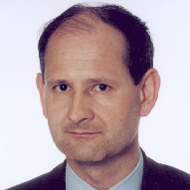Kubička Miroslav
- Year of Birth :
- 1951
Biography
Miroslav Kubicka hails from South Bohemian town of Pisek where he began to play the piano at the People's Art School under Marie Tikalova. While studying at the public grammar school he used to go to Prague to consult his first compositional attempts with Professor Zdenek Hula (1967 - 1970). In 1970 he was admitted to the compositional class of Jiri Pauer at the Academy of Perfoming Arts in Prague. He graduated with Concerto for Piano and orchestra in 1975. He enhanced his experience as composer under Franco Donatoni in Italy (1973) and by postgraduate studies of musical theory at the Academy (1978-79). Today he is a teacher at the Jan Deyl Conservatory in Prague. He is a member of the Union of Czech Composers and Concert Artists and the spokesman of the association HARMONIA (association for musical performances). Chamber works predominate in Kubicka' s compositional output, but he also scored great success with his Symphony for Large Orchestra performed in 1981 by the Prague Symphony Orchestra under Jiri Belohlavek at the 'Week of New Works', and it was awarded the annual prize of the Union of Czech Composers and Concert Artists (in 1982). In the eighties the composer attracted attention by string quintet called Conversations and by a new rendition of older vocal cycle A Song of Hidden Beauty - this time for the performarnce within the framework of the Mladé podium 1984 /'Young Podium Festival'/ in Karlovy Vary.
While a student in Prague Kubicka had a short dodecaphonic period, he was then attracted by Pierre Boulez, but tonality is closer to his nature and he turned back to it soon. Today he is a follower of compositional expression linked firmly with tradition; he started off from the world classics of the 20th century music and had a special liking for Czech neoclassical composer Isa Krejci. He favours stylistic synthesis and explains his understanding of it as follows: "I imagine synthesis as a combination of some modern compositional procedures with such traditional achievements which are tenable in my opinion". In his one-movement Conversations (The Chats) for five string instruments he wrote a thorough and detailed work in which he also achieved a new kind of modern simplicity. It can be said that it was to the advantage of that composition which became more cohesive without losing attractiveness to listeners. Kubicka's interesting polyphonic work has also contributed to the achievement of greater stylistic cohesiveness. The Second Piano Concerto (dedicated to prominent Czech pianist Ivan Klansky) is another significant composition from the eighties.
From the end of the 1990s there is a composition Three Frescoes which was premiered in Avignon on July 2002, and later on performed at the overview of contemporary music 'Prague Premieres 2005'. This composition was commissioned by abbé Georges Durand, and the composers' s intention was to symbolize by his work the affinity of three European significant cultural centres - Avignon, Bologne and Prague. From more recent works there are worth mentioning Quartet in C for flute, violin, violoncello and piano (2000 - 2001), or Sonata for trombone and piano (2004-2006, in three movements).
© 2012-2025 Musicbase.cz
Webdesign & hosting Nux Ltd.
Information about web | Sitemap | RSS | Statistics | CMS
Contact information
Music information center, o.p.s.
tel: 257 312 422 | e-mail: his@musica.cz

